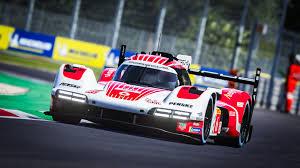France Le Mans- The Enduring Evolution of the 24 Hours of Le Mans: A Century of Speed, Safety, and Innovation. (Part 2)

The Balance of Performance (BoP) is a critical and continuously evolving system applied to the Hypercar and LMGT3 classes. Its primary aims are to ensure sporting fairness between cars of different engineering designs and to control costs by slowing down the development race, as manufacturers know their cars will be balanced. The system compensates for various performance parameters, including differences between two-wheel drive and four-wheel drive cars, aerodynamic performance, center of gravity, and even refueling time. BoP calculations are subject to continuous refinement; for example, the system now considers an average of 60% of the best race laps (a significant change from the previous 20%) to account for factors like tire degradation and to balance drivers within the LMGT3 class. The ultimate goal is "100% convergence on laptime" in theory. Innovative solutions, such as the implementation of torque meters on driveshafts, are now used to measure and limit the BoP-allocated power on track, further enhancing control and limiting development costs.
This evolution in regulatory philosophy, from early regulations focused on achieving specific distances or directly limiting resources (like fuel in Group C) to the modern reliance on the Balance of Performance system, represents a significant shift. BoP aims to "maintain a similar level of performance" and "prevent cost escalations" by dynamically adjusting parameters. This indicates a move towards a more dynamic, post-hoc adjustment system that seeks to level the playing field
between diverse technical approaches. The underlying rationale is to encourage broader manufacturer participation by controlling costs and ensuring competitive racing, rather than dictating a single, narrow technical solution. This reflects a maturation of motorsport management, moving towards a more sophisticated system that balances technical freedom with competitive parity and financial sustainability, ultimately aiming for a more exciting, diverse, and economically viable grid.
To be officially classified as a finisher, a car must meet specific requirements beyond simply completing 24 hours. It must complete the last lap of the race within a prescribed maximum lap time (now with penalties for exceeding it, as demonstrated by the 2016 Toyota incident) and must complete at least 70% of the distance covered by the overall winner. The historical practice of intentionally "waiting for the final lap" with damaged cars to crawl across the line has been prohibited by recent rules.


Table 2: Evolution of Le Mans Car Classes
|
Era/Years |
Class Name(s) |
Key Characteristics/Purpose |
Examples of Prominent Cars/Manufacturers |
Impact on Competition and Innovation |
|
1923-1927 |
Rudge-Whitworth Triennial Cup (Early Format) |
Initial focus on target distances over 3 years for durability proof
|
Chenard & Walcker, Bentley, Bugatti |
Established endurance as core, but complex system quickly abandoned for single-race distance. |
|
1928-1970s |
Various (e.g., Grand Touring, Prototypes) |
Focus on speed and reliability; open-cockpit to closed-cockpit evolution
|
Bentley, Alfa Romeo, Ferrari, Ford GT40 |
Drove significant advancements in engine, aerodynamics, safety (post-1955). Intense factory rivalries. |
|
1970s-1992 |
Group C |
Limited fuel allowance to encourage fuel economy due to oil crisis
|
Porsche 956/962, Sauber-Mercedes, Jaguar |
Pushed efficiency and aerodynamics; created iconic, high-speed prototypes. |
|
1990s-2020 |
LMP1, LMP2, GT1/GT2/GTE |
Hierarchical prototype and production-based classes; varying levels of factory vs. privateer involvement
|
Audi R8/R10/R18, Porsche 919 Hybrid, Toyota TS050 Hybrid |
Continued technological push, especially in hybrid powertrains; refined multi-class racing. |
|
2021-Present |
Hypercar (LMH/LMDh), LMP2, LMGT3 |
Top-tier prototypes with cost control and BoP; privateer-focused LMP2; production-based GT3
|
Toyota, Ferrari, Porsche, Cadillac (Hypercar); Corvette, Ford, Ferrari (LMGT3) |
Attracted major manufacturer return; balanced competition; focus on sustainability and cost efficiency. |
Race Procedures and Driver Management: Pit stops have undergone a dramatic transformation from a basic necessity (refueling and tire changes often taking several minutes with rudimentary equipment) to a highly strategic, high-precision operation. Modern pit stops are a "marvel of teamwork and technology," with each crew member having a specific role and teams practicing relentlessly to shave off precious tenths of a second. Strict rules govern pit lane procedures. Drivers must not exceed 60 kph in the pitlane and must stop in front of their garage with the engine turned off before any intervention. Mechanics are permitted to change wheels and refuel simultaneously, but major repairs (like engine or chassis changes) require the car to be pushed into its garage, where the entire team can work. Only four mechanics are allowed to work on the car in the pitlane during a stop.
The pit lane is generally closed during Full Course Yellow (FCY) or safety car periods to maintain race integrity. However, rules recognize the risk of cars running out of fuel, allowing for emergency refueling (approximately 20% energy) for cars low on fuel. Such cars are then required to make an immediate second stop as soon as the safety car period ends. Similar provisions exist for tire changes during FCY.
To manage driver fatigue and ensure safety over 24 hours, teams typically field three drivers who rotate driving duties, swapping places every few hours. According to Le Mans regulations, the maximum time a driver can be at the wheel in a single stint is 240 minutes. Drivers are also categorized (Bronze, Silver, Gold, Platinum) based on their race record and achievements, influencing line-up requirements in certain classes.
Over the 62 years since qualifying times first determined grid positions, Le Mans has utilized five different grid-deciding methods. The modern "Hyperpole" format, introduced from 2020, involves multiple sessions: an initial qualifying session, with the top cars (top 12 in LMGT3 and LMP2, top 15 in Hypercar) advancing to a shootout session. This format groups cars by speed in separate categories for qualifying.


The Le Mans rulebook covers both "technical" (car design, equipment) and "sporting" (driver conduct, race procedures) aspects. The 1955 disaster directly led to "widespread introduction of safety measures" , including circuit modifications like the Mulsanne chicanes and driver time limits to prevent fatigue. Pit lane speed limits and safety car procedures are also fundamentally safety-driven. Simultaneously, classification rules (70% distance, last lap completion) , the BoP system , and the evolving qualifying formats are all meticulously designed to foster intense and fair competition. This highlights a constant, and often challenging, balancing act between ensuring a thrilling and equitable race and safeguarding the lives of participants and spectators. Le Mans' rulebook is a living, adaptive document, constantly evolving in response to the inherent tension between pushing performance limits and ensuring safety. This dynamic interplay is a defining characteristic of the race's evolution, demonstrating a deep commitment to responsible motorsport and its continuous improvement.
Circuit Modifications: Adapting to Speed: The Circuit de la Sarthe is a unique and challenging track, a mixture of closed public roads and dedicated racing sections, featuring 38 turns. A significant evolution of the circuit involved the Mulsanne Straight. While cars famously reached speeds of 407 km/h (253 mph) along it in 1988, chicanes were subsequently added to reduce speeds and enhance safety. These modifications, while limiting outright top speed, have undeniably made the Mulsanne safer and remain a critical part of the circuit's character.
A unique aspect that demonstrates Le Mans' willingness to embrace radical, future-oriented, or humanitarian innovations outside the direct competitive framework is the "Garage 56" entry. This special, non-competitive slot, listed in the race's history , allows highly experimental technologies (e.g., hydrogen prototypes ) or socially significant projects (like Frederic Sausset's adapted car, which enabled him to become the first quadruple amputee to finish ) to participate without needing to conform to the strict competitive class regulations. It serves as a showcase for future technologies or unique engineering challenges, reinforcing the race's role as a testbed beyond just performance, highlighting its broader societal relevance and its commitment to pushing boundaries in diverse ways, even if not for outright victory.
Table 3: Major Rule Changes and Their Rationale
|
Year/Era |
Specific Rule Change |
Rationale/Purpose |
Direct Impact/Consequence on the Race or Cars |
|
1928 |
Abandonment of Rudge-Whitworth Triennial Cup |
Pragmatic shift to simpler, more direct measure of endurance
|
Winner determined by furthest distance in single 24-hour race; solidified core competitive principle. |
|
1955 |
Widespread safety measures post-disaster |
Enhance safety for participants and spectators
|
Pit complex rebuilt, track widened; influenced global motorsport safety regulations. |
|
Early 1970s |
Group C fuel economy formula |
Respond to oil crisis, encourage fuel efficiency
|
Limited fuel allowance; fostered innovation in engine efficiency and aerodynamics. |
|
1988-1990 |
Addition of chicanes on Mulsanne Straight |
Reduce excessive speeds, enhance safety
|
Limited top speeds (from 407 km/h); made the straight safer, changed driving dynamics. |
|
2010 |
Refueling banned (in F1, influencing WEC trends) |
Focus on tire management and pit stop efficiency
|
Pit stops became solely about tire changes, emphasizing crew precision and strategy. |
|
2012 |
70% distance classification rule |
Ensure reliability/speed for classified finishers
|
Cars must complete significant portion of winner's distance; prevents uncompetitive cars from being classified. |
|
2016 |
Penalty for exceeding max final lap time |
Prevent damaged cars from crawling across finish line for classification
|
Ensured competitive integrity of final lap; Toyota 2016 incident highlighted its importance. |
|
2020 |
Introduction of Hyperpole qualifying format |
Group cars by speed for qualifying; enhance competitive spectacle
|
Multi-stage qualifying with shootouts for top positions in each class. |
|
2021 |
Hypercar class (LMH/LMDh) introduced |
Prevent cost escalation; enable technical diversity; attract manufacturers
|
Renewed top-tier manufacturer participation; competitive balance via BoP. |
|
2022 |
100% renewable fuel mandate |
Reduce carbon footprint, promote sustainability
|
Significant reduction in GHG emissions; industry-leading environmental initiative. |
|
2024 |
LMGT3 class replaces GTE |
Adopt existing GT3 platform; increase manufacturer diversity
|
Broader range of production-based GT cars; increased privateer participation. |
|
Ongoing |
Balance of Performance (BoP) refinement |
Ensure sporting fairness; control development costs
|
Dynamic adjustments to equalize diverse car designs; promotes close racing and manufacturer engagement. |
V. Le Mans Today: A Global Spectacle and Innovation Hub
The 24 Hours of Le Mans remains the pinnacle event of the FIA World Endurance Championship (WEC), attracting global attention and serving as its marquee race. The top Hypercar class currently features a diverse and highly competitive array of major manufacturers, signifying a renaissance in top-tier endurance racing. These include established giants like Toyota, Ferrari, Porsche, and Cadillac, alongside returning marques such as Aston Martin, Alpine, BMW, and Peugeot, all competing with either LMH or LMDh platforms. This unprecedented level of manufacturer diversity and commitment in the top class, especially after periods of reduced factory involvement, is a strong indication of a successful regulatory framework. The BoP system, cost control measures, and the technical freedom within limits appear to have successfully encouraged this resurgence. The current Hypercar regulations, particularly the sophisticated application of the BoP system, have successfully re-attracted major global automotive brands to the pinnacle of endurance racing. This ensures the race's continued prestige, its role as a high-stakes, relevant proving ground for cutting-edge automotive technology, and signifies a healthy and vibrant competitive landscape for the foreseeable future.
The LMGT3 class also boasts significant manufacturer representation, with nine major makes expected to be represented by private teams in 2025, including Ferrari, Aston Martin, Porsche, BMW, Ford, McLaren, Lexus, Corvette, and Mercedes-AMG. This ensures a vibrant and diverse field across all categories. The Balance of Performance (BoP) system is crucial for maintaining competitive parity across these diverse entries, ensuring close racing, controlling development costs, and attracting such a wide range of manufacturers.
Le Mans continues to be an "ideal testing ground" for technological innovations, with its extreme conditions pushing the boundaries of vehicle design and performance. The strict application of regulations ensures that advancements made on the track are not merely theoretical but are robustly proven, allowing them to effectively benefit production cars and contribute to broader automotive progress. The ongoing pursuit of speed, coupled with the imperative of enduring 24 hours without mechanical failure, still drives innovation in critical areas such as aerodynamics, engine efficiency, lightweight materials science, and advanced electronics.
VI. The Road Ahead: Sustainable Futures
Demonstrating a concrete step towards environmental responsibility, since 2022, all cars participating in the 24 Hours of Le Mans have been mandated to use Excellium Racing 100, a 100% renewable fuel supplied by TotalEnergies. This bioethanol-based fuel is produced from wine residues from the French agricultural industry and from ETBE sourced from the circular economy, allowing for significant greenhouse gas (GHG) emissions savings of at least 65% compared to traditional fossil fuels. This immediate adoption across all classes highlights a pragmatic approach to reducing the carbon footprint of existing race formats.
Looking further into the future, Le Mans is actively spearheading the development and integration of hydrogen as a propulsion technology through the ambitious "MissionH24" program. This initiative extends Le Mans' historical role as an innovation testbed into the realm of environmental sustainability. Bosch Motorsport is a key official partner in this endeavor, contributing its extensive motorsport experience and hydrogen expertise. They are developing high-performance hydrogen engines and, crucially, safe and efficient storage systems, including the innovative L-HSCU liquid hydrogen storage control unit. The H24EVO prototype, developed as part of MissionH24, is a fuel-cell-powered demo vehicle specifically designed to test hydrogen technology under the extreme conditions of endurance racing. A significant recent development in the program is the shift from high-pressure gaseous hydrogen to cryogenic liquid hydrogen for the H24EVO. Liquid hydrogen offers a higher volumetric density, which is critical for achieving compact tank designs necessary for race cars, addressing a key packaging challenge.
The adoption of 100% renewable fuel for all cars since 2022 is a significant, immediate step towards reducing the race's carbon footprint. This is complemented by the ambitious, long-term commitment to hydrogen through the MissionH24 program. This dual approach (immediate emissions reduction via sustainable fuels for current classes, and future transformation via hydrogen propulsion) demonstrates a proactive and comprehensive strategy towards environmental responsibility. It positions Le Mans at the forefront of sustainable motorsport development. Le Mans is actively shaping the future of motorsport and potentially influencing the direction of road transport by investing heavily in sustainable technologies. This reinforces its historical role as an innovation leader, now with a critical environmental mandate, ensuring its continued relevance and leadership in a world increasingly focused on climate action.
ACO President Pierre Fillon has publicly reiterated plans for a phased introduction of hydrogen technology into the Hypercar class, acknowledging the complexity and safety considerations involved. The H24EVO is expected to make public appearances and begin its crucial liquid hydrogen track tests in April 2026, following design finalization and bench-testing phases. The ultimate goal is for the first hydrogen-powered cars to compete at Le Mans in June 2028, aiming to establish a dedicated hydrogen class within the FIA World Endurance Championship. This long-term vision demonstrates a commitment to a sustainable future for endurance racing. This phased approach demonstrates a commitment to ensuring the safety, reliability, and competitive viability of new technologies before their full integration into high-stakes racing. It reflects the lessons learned from a century of automotive development, where pushing boundaries requires careful validation and iterative refinement, ultimately leading to more robust and successful technological transitions.

VII. Conclusion: Le Mans' Enduring Legacy
The 24 Hours of Le Mans has consistently evolved over its century-long history, driven by its foundational purpose of rigorously testing and proving automotive durability and reliability. This core mission has remained constant, even as the challenges and technologies have changed. Safety imperatives, particularly following the profound impact of the 1955 disaster, have fundamentally shaped both the circuit's design and the regulatory framework, leading to continuous improvements that have benefited motorsport globally.
The race has served as an unparalleled proving ground for technological advancements, with a consistent and verifiable track record of innovations transitioning from the competitive environment of the Circuit de la Sarthe to the broader automotive industry and consumer vehicles. Regulatory frameworks, including the dynamic class structures and the sophisticated Balance of Performance system, have continually adapted to foster competitive fairness, control escalating costs, and encourage broad manufacturer participation, ensuring the race's economic and sporting vitality. The ongoing commitment to sustainability, exemplified by the adoption of renewable fuels and the pioneering development of hydrogen technology, ensures Le Mans' continued relevance and leadership in the 21st century, addressing global environmental challenges.
The 24 Hours of Le Mans remains a unique and compelling blend of human endurance, cutting-edge engineering prowess, and strategic acumen. It embodies the enduring spirit of automotive innovation and human perseverance. Its rich history is a powerful testament to the relentless pursuit of excellence in motorsport, continually pushing the boundaries of what is possible in automotive engineering and endurance racing, and solidifying its status as one of the world's truly iconic sporting events.
- Bicycle world
- Motorbike world
- E-Bike World
- Auto parts world
- MotorSports
- Auto World
- Art
- Causes
- Crafts
- Dance
- Drinks
- Film
- Fitness
- Food
- Jogos
- Gardening
- Health
- Início
- Literature
- Music
- Networking
- Outro
- Party
- Religion
- Shopping
- Sports
- Theater
- Wellness


